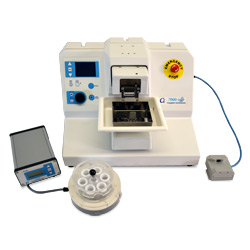[►Jump straight to PUBLICATIONS]
In the world of botany, precision and accuracy are essential for studying plant structures at a microscopic level. Plant samples vary greatly in texture, density, and composition, requiring a vibratome that offers adjustable parameters to ensure optimal sectioning. Our vibrating microtomes are designed to provide thin, high-quality slices with minimal damage while considering how samples vary to ensure that researchers can slice plant tissues with ease with customizable slicing parameters. Whether you are working in academia, agriculture, or biotechnology, our vibratomes offer the reliability you need to answer your research questions.
Read the Application Note:

Model 7000smz-2
Our top of the range high precision, vibrating microtome, this is the finest tissue slicer in the world for preparations for visual patch clamping. Shown with optional Slice incubation chamber and temperature controller.

Model 5100mz-Plus
The 5100-Plus is perfect for those who need to keep slices viable for longer e.g. for electrophysiological field recordings. The user can calibrate the Z-axis deflection of the blade to 2 µm with the adjustable blade holder and "Opti-cal" Calibration device.

Model 5100mz
The 5100mz is a very competitively priced, high precision, vibrating microtome (vibrotome for short) which shares many features with the top of the range 7000smz series, such as the vibrating mechanism, the inner and outer tissue baths and the easy to use control system.
With the user-friendly design, our vibratomes enable researchers to unlock new insights in the plant sciences. Whether your sample has or has not been sliced before, we encourage you to try slicing on a Campden vibratome.
To learn more about what plant scientists around the world have done using Campden vibratomes, check out the application note above and explore references from users across the globe to see how our vibratomes are being used.
2024
Pan, H., Shim, A., Lubin, M. B., & Belin, B. J. (2024). Hopanoid lipids promote soybean–Bradyrhizobium symbiosis. Mbio, 15(4), e02478-23. https://doi.org/10.1128/mbio.02478-23
2023
Hermanowicz, P., Giza, A., & Łabuz, J. (2023). Sensitive detection of chloroplast movements through changes in leaf cross-polarized reflectance. bioRxiv, 2023-10. https://doi.org/10.1101/2023.10.24.563792
2022
Coles, D. W., Bithell, S. L., Mikhael, M., Cuddy, W. S., & Plett, J. M. (2022). Chickpea roots undergoing colonisation by Phytophthora medicaginis exhibit opposing jasmonic acid and salicylic acid accumulation and signalling profiles to leaf hemibiotrophic models. Microorganisms, 10(2), 343. https://doi.org/10.3390/microorganisms10020343
Fusi, R., Rosignoli, S., Lou, H., Sangiorgi, G., Bovina, R., Pattem, J. K., ... & Salvi, S. (2022). Root angle is controlled by EGT1 in cereal crops employing an antigravitropic mechanism. Proceedings of the National Academy of Sciences, 119(31), e2201350119. https://doi.org/10.1073/pnas.2201350119
Kumar, P., Cowan, G. H., Squires, J. N., Hackett, C. A., Tobin, A. K., Torrance, L., & Roberts, A. G. (2022). Phloem connectivity and transport are not involved in mature plant resistance (MPR) to Potato Virus Y in different potato cultivars, and MPR does not protect tubers from recombinant strains of the virus. Journal of Plant Physiology, 275, 153729. https://doi.org/10.1016/j.jplph.2022.153729
Plett, K. L., Snijders, F., Castañeda‐Gómez, L., Wong‐Bajracharya, J. W. H., Anderson, I. C., Carrillo, Y., & Plett, J. M. (2022). Nitrogen fertilization differentially affects the symbiotic capacity of two co‐occurring ectomycorrhizal species. Environmental Microbiology, 24(1), 309-323. https://doi.org/10.1111/1462-2920.15879
Vanhees, D. J., Schneider, H. M., Sidhu, J. S., Loades, K. W., Bengough, A. G., Bennett, M. J., ... & Lynch, J. P. (2022). Soil penetration by maize roots is negatively related to ethylene‐induced thickening. Plant, Cell & Environment, 45(3), 789-804. https://doi.org/10.1111/pce.14175
2021
Ballesteros, H. G. F., Rosman, A. C., Carvalho, T. L. G., Grativol, C., & Hemerly, A. S. (2021). Cell wall formation pathways are differentially regulated in sugarcane contrasting genotypes associated with endophytic diazotrophic bacteria. Planta, 254, 1-21. https://doi.org/10.1007/s00425-021-03768-0
De Meester, B., Vanholme, R., de Vries, L., Wouters, M., Van Doorsselaere, J., & Boerjan, W. (2021). Vessel‐and ray‐specific monolignol biosynthesis as an approach to engineer fiber‐hypolignification and enhanced saccharification in poplar. The Plant Journal, 108(3), 752-765. https://doi.org/10.1111/tpj.15468
Jones, D. H., Atkinson, B. S., Ware, A., Sturrock, C. J., Bishopp, A., & Wells, D. M. (2021). Preparation, scanning and analysis of duckweed using x-ray computed microtomography. Frontiers in Plant Science, 11, 617830. https://doi.org/10.3389/fpls.2020.617830
2020 and Prior
Burr, C. A., Sun, J., Yamburenko, M. V., Willoughby, A., Hodgens, C., Boeshore, S. L., ... & Kieber, J. J. (2020). The HK5 and HK6 cytokinin receptors mediate diverse developmental pathways in rice. Development, 147(20), dev191734. https://doi.org/10.1242/dev.191734
Plett, J. M., Plett, K. L., Wong‐Bajracharya, J., de Freitas Pereira, M., Costa, M. D., Kohler, A., ... & Anderson, I. C. (2020). Mycorrhizal effector PaMiSSP10b alters polyamine biosynthesis in Eucalyptus root cells and promotes root colonization. New Phytologist, 228(2), 712-727. https://doi.org/10.1111/nph.16759
De Meester, B., De Vries, L., Özparpucu, M., Gierlinger, N., Corneillie, S., Pallidis, A., ... & Boerjan, W. (2018). Vessel-specific reintroduction of CINNAMOYL-COA REDUCTASE1 (CCR1) in dwarfed ccr1 mutants restores vessel and xylary fiber integrity and increases biomass. Plant Physiology, 176(1), 611-633. https://doi.org/10.1104/pp.17.01462
Yu, S., Huang, A., Li, J., Gao, L., Feng, Y., Pemberton, E., & Chen, C. (2018). OsNAC45 plays complex roles by mediating POD activity and the expression of development-related genes under various abiotic stresses in rice root. Plant Growth Regulation, 84, 519-531. https://doi.org/10.1007/s10725-017-0358-0
Atkinson, J. A., & Wells, D. M. (2017). An updated protocol for high throughput plant tissue sectioning. Frontiers in plant science, 8, 1721. https://doi.org/10.3389/fpls.2017.01721